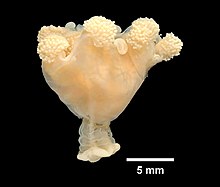Haliclystus auricula
| Haliclystus auricula | |
|---|---|

| |
| Scientific classification | |
| Kingdom: | Animalia |
| Phylum: | Cnidaria |
| Class: | Staurozoa |
| Order: | Stauromedusae |
| Family: | Haliclystidae |
| Genus: | Haliclystus |
| Species: | H. auricula
|
| Binomial name | |
| Haliclystus auricula Rathke, 1806
| |
| Synonyms | |
| |
Haliclystus auricula is a stalked jellyfish found in the Northern hemisphere. It is the type species for its genus.
Name[]
In 2010, Natural England, The Guardian and the Oxford University Museum of Natural History ran a competition asking members of the public to provide a common name for this species. The name "Kaleidoscope Jellyfish," submitted by Kepler Petzall, was eventually chosen.[1] Runner-up names included Fractal flower jellyfish and Mermaid's trumpet jellyfish.[1]
Description[]
H. auricula is 2-2.5 cm tall with the stalk accounting for half of the height of the organism. The remainder of the organism is shaped like a funnel, the colour of which varies across the species from grey/green to red/brown. It has eight arms which radiate out from a central mouth. Each arm is tipped by clusters of up to 100 tentacles and connected by a thin membrane. Primary tentacles known as anchors are located on the membrane margin between the arms. The kidney-shape of these appendages is a key distinguishing feature of this species.[2]
Distribution[]
H. auricula is one of ten species of Haliclystus found in the Northern hemisphere.[3] It is very sensitive to pollution. The populations along the British coastline are in decline.[4] Distribution includes the Shetland Isles, Orkney, western coast of England, Scotland and Ireland.[5]
Habitat[]
This species lives in shallow water that has adequate circulation on marine eelgrass and other algae.[2] Depths they are found in range from mid-eulittoral to shallow sublittoral.[6] H. auricula is able to move location by attaching a specialised tentacle to the substrate as an anchor, detaching its base and 'cartwheeling' into the new position.[4]
Lifecycle[]
This species reproduces by sexual means. H. auricula is most abundant in a given location in midsummer.[7] Like all stalked jellyfish, a single H. auricula individual is believed to live for only one year.[7] Diet consists of benthic species, primarily crustaceans.[8]
References[]
- ^ a b "Natural England - Haliclystus auricula - Kaleidoscope jellyfish". Archived from the original on 12 March 2012. Retrieved 1 August 2010.
- ^ a b Collins, Allen G. (2010). Haliclystus auricula (Rathke, 1806). Accessed through: World Register of Marine Species at http://www.marinespecies.eu/aphia.php?p=taxdetails&id=135322 on 2010-08-01
- ^ Miranda, Lucília S.; Morandini, André C.; Marques, Antonio C. (2009). "Taxonomic review of Haliclystus antarcticus Pfeffer, 1889 (Stauromedusae, Staurozoa, Cnidaria), with remarks on the genus Haliclystus Clark, 1863". Polar Biology. 32 (10): 1507. doi:10.1007/s00300-009-0648-8.
- ^ a b "The beautiful, coral-like jellyfish: Haliclystus auricula". The Guardian. 25 June 2010.
- ^ "MarLIN - The Marine Life Information Network - Kaleidoscope jellyfish (Haliclystus auricula)". www.marlin.ac.uk. Retrieved 3 March 2021.
- ^ "Staromedusea". www.marlin.ac.uk. Retrieved 3 March 2021.
{{cite web}}: CS1 maint: url-status (link) - ^ a b Corbin, P. G. (1979). "The seasonal abundance of four species of Stauromedusae (Coelenterata: Scyphomedusae) at Plymouth". Journal of the Marine Biological Association of the United Kingdom. 59 (2): 385–391. doi:10.1017/S0025315400042697.
- ^ "WoRMS - World Register of Marine Species - Haliclystus auricula James-Clark, 1863". www.marinespecies.org. Retrieved 3 March 2021.
External links[]
- Haliclystidae
- Animals described in 1806